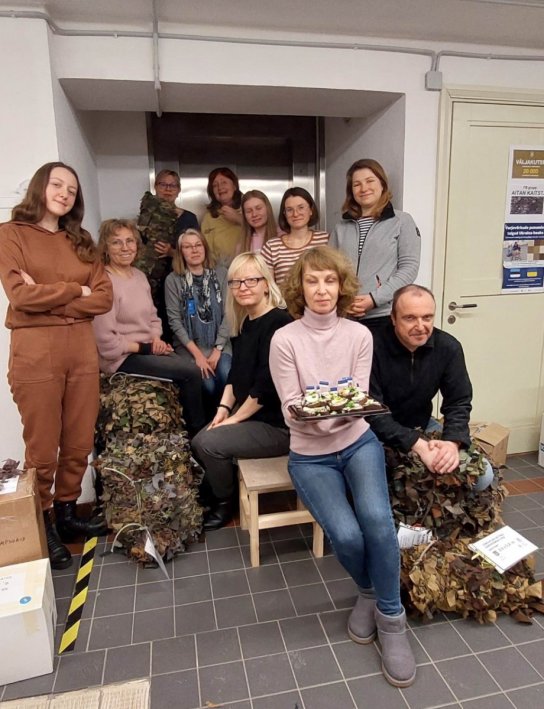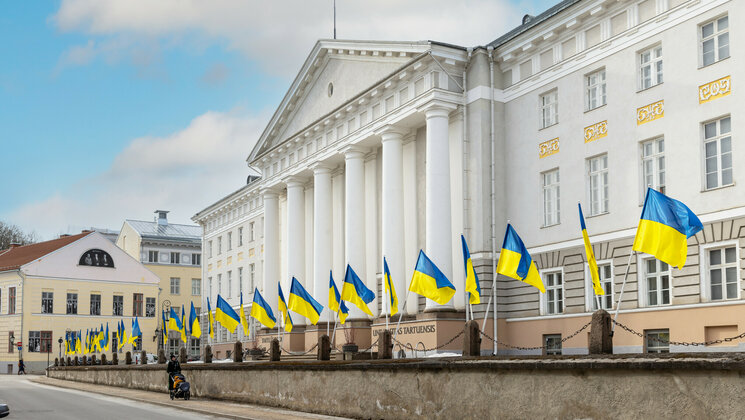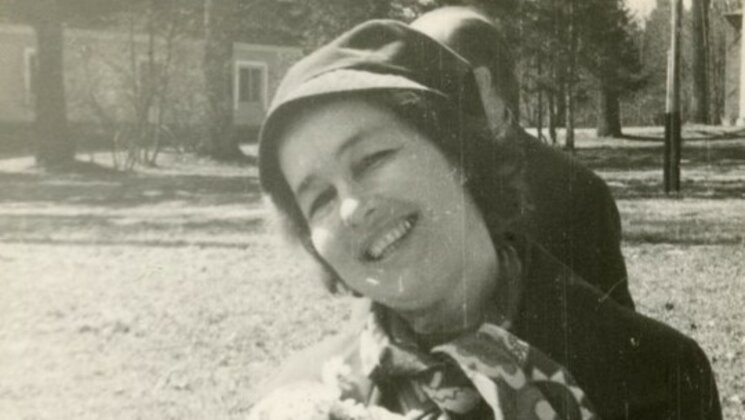Estonian volunteers have woven 20,000 square metres of camouflage nets, equalling the area of nearly three football stadiums

By participating in the Aitan Kaitsta initiative, University of Tartu staff help defend Ukraine by making camouflage nets and helmet covers.
The Aitan Kaitsta (Helping Defend) action of weaving camouflage nets was born on the third week of the war out of the need and desire to help the defenders of Ukraine. It was initiated by Anu Lensment, a fashion designer affiliated with Estonian Television, and Jana Ratas, a technician at the University of Tartu Institute of History and Archaeology. The initiative grew into the non-profit organisation Aitan Kaitsta, which organises the making of defence products for Ukraine. Its headquarters is in Tallinn, but work is carried out in many towns and villages across Estonia, including two study buildings of the University of Tartu.
By the beginning of 2023, the volunteers of the Aitan Kaitsta community had woven 16,000 m2 of camo nets, equalling the area of two football stadiums and three basketball courts. Then a target was set to send a total of 20,000 m2 of nets to Ukraine by 24 February. Thanks to all volunteer weavers across Estonia, this was achieved on 23 February. The last few hundred square metres came from Southern Estonia, the collection centre of which is the University of Tartu, which contributed 3,000 m2.
Reaching 20,000 m2 was just one small step on a long road ahead. But it is the small goals and targets that help to motivate the weavers from time to time, reminding them that what they are doing is much needed and worth doing. Recognition also goes a long way, showing that bold citizen initiatives are appreciated. Awarding the state decoration Order of the White Star, 5th class, to Jana Ratas and Anu Lensment as the founders of the MTÜ Aitan Kaitsta was very motivating. It was also heart-warming to see the launch of the camo netting campaign receive a special award at the annual awards gala of Estonian museums.
One milestone has been reached and new ones are waiting to be set so that the long war does not seem endless. We have been planning our rear-guard activities in advance – already in the autumn, we collected white textiles for winter nets, although we sincerely hoped that the war would not last much longer and that there would be no need for winter nets. Unfortunately, this hope was not fulfilled, and work must continue.
The University of Tartu is contributing to the defence of Ukraine by sending camo nets and helmet covers and will continue to do so for as long as necessary. In the process, we have gathered a lot of valuable information on how to make camo nets from recycled materials, where to get the materials, how to weave quickly and economically, and how to involve volunteers with very different craft skills. Once the war in Ukraine ends, the Aitan Kaitsta community can also use their experience to benefit Estonia's national defence.
The organisers are most grateful to all the weavers and others who have helped with the transport, brought materials and contributed otherwise.
Handmade masking and camouflage nets are highly valued defence products. The lifespan of vehicles covered with masking nets is significantly longer – on the front, a camouflage net is as an indispensable part of a vehicle's equipment as a shovel or a tow rope. The nets are also used to cover other objects such as trenches, military machinery, and important landmarks in nature and the city.
Industrial camouflage nets are also sold online, but military professionals prefer handmade nets because they look more natural and fade into the natural environment. As they are woven by different people, they do not end up having easily recognisable and machine-recognisable patterns, which is very important, for example, for protection against drones.
In Tartu, camo nets and helmet covers are continuously made in two buildings of the University of Tartu: Jakobi 2 and Omicum (Riia 23b/2). While the Tallinn headquarters collects nets made in Northern Estonia and on the islands, the University of Tartu's Jakobi 2 building has become a collection centre for camo nets made in Southern Estonia. The support of the institutes in providing space and every help of the university community has been very important, and we hope it will continue until the end of the war.
People of any age can participate in rear-guard activities, from schoolchildren to pensioners. Everyone can find suitable work: obtain and dye material, cut textile strips for weaving, weave, prepare the netting or pack nets. Besides camo nets, it is possible to make helmet covers, which everyone can make conveniently at home. The method of making helmet covers is essentially the same as for nets; it is important to break up the actual shape of the helmet and make it difficult to target the soldier.
The nets are mostly made in two academic buildings. While initially more university students and staff participated, now Ukrainians – both locals and war refugees – have taken over. However, a core group of university employees and friends, who have been with us from the beginning, have remained.
The first three camouflage nets made in the Jakobi 2 building were dispatched on 13 April 2022, only a few weeks after the weaving started. On the same day, the first net was set up in Omicum and the first net weaving workshops for the employees of the institutes took place. To date, 100 nets covering more than 3,000 m2 have been completed at the university's two weaving sites.
In addition to the camo nets, also other things needed during the war – warm clothes, socks, gloves, hats, trench candles, honey, sweets and many other things needed on the front, donated by good Estonian people, have been sent to Ukraine from us since November 2022. Since December 2022, we have made and sent to the front 64 helmet covers.
Weavers often ask to which Ukrainian region the nets are sent, and the answer "We send them to Ukraine" is usually not enough for them. We trust our partners in Ukraine and know it is impossible to talk about all things, let alone photograph them, in the war situation. We do know that at the end of 2022, during the joint project "Estonian Sauna to Ukraine", nets were needed for the Karpatska Sich 49th Infantry Battalion of the Ukrainian Ground Forces. The nets woven in February 2023 were taken directly to the city of Sambir. All in all, camo nets have been sent to more than 170 battle areas.
Nets made in the buildings of the University of Tartu have been delivered to Ukraine by several NGOs: Slava Ukraini, Vaba Ukraina and United Delivery Mission. Communication with the latter has been the most active. Private persons have also taken completed nets to Ukraine in suitcases.
Jana and Anu are in direct contact with partners in Ukraine and can give us the latest news and guidance (for example, what the landscape is like on the site and in what colours and how many nets are needed).
All helping hands are most welcome
Anyone can contribute to camo netting by bringing materials, helping to cut them or weaving the nets. Come on your own, with friends or colleagues!
There is a separate mailing list for sharing information about camo netting at Jakobi 2. Subscribers can get information on when weaving campaigns take place and which materials are needed. You can join the mailing list by filling in the form on https://lists.ut.ee/wws/subscribe/projekt.varjevorgutalgud or writing to Kristel Kajak (kristel.kajak@ut.ee).
At the University of Tartu, camo nets are woven at
- Omicum (Riia 23b/2) from Mondays to Fridays from 9 to 17
- Philosophicum (Jakobi 2) on Wednesdays from 16 to 20
Last week, camo netting also started in the Mens’ Shed in Annelinn (Anne 46a, Tartu). The contact person is Küllike Pihkva and weavers are welcome on Fridays from 17 to 21. For more information, see the Facebook page.
Instead of throwing away worn-out clothes and textiles, you can recycle them by bringing them to the collection box in the lobby of Jakobi 2. We collect
- textiles and clothing – bed linen, thin cotton clothing, T-shirts, dress shirts and leftover fabrics;
- fabric dyes of all colours (we mix them) meant for cotton, wool and synthetics.

Celebrating the completion of 20,000 m2 of camo nets at Jakobi 2 on 23 February. Photo by Sandra Sammler






